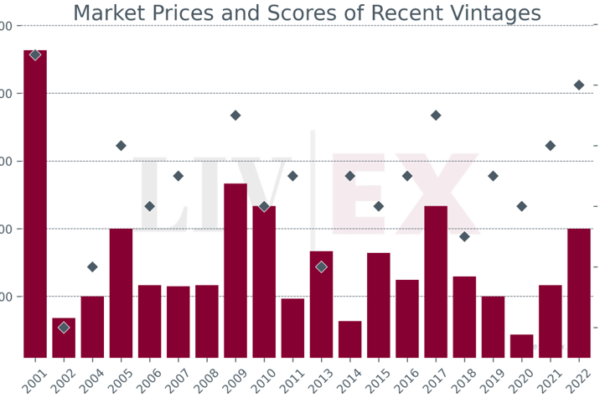
Owner: Thienpont family
Classification: Unclassed Pomerol
Vineyard area: 2.7 hectares
Average annual production: 5,000-6,000 bottles p/a
Colour: Red
Standard blend: 100% Merlot
History
As well as being one of the world’s most exclusive blue-chip wines, Le Pin is something of an anomaly in Bordeaux, where many of the region’s finest offerings boast a pedigree stretching back several centuries. The winery has its roots in the more recent past, when the Thienpont family (owners of Vieux Chateau Certan) purchased a vineyard in Pomerol from an elderly villager named Madame Laubie in 1979. Prior to the Thienponts’ acquisition of the land, the vineyard’s produce had been sold as generic Pomerol. The change in ownership brought with it new investment, however, and the first vintage of Le Pin (1979) – which was named after the two pine trees that grow near the vineyard – was blended in the basement of the property’s modest farmhouse. In the early 1980s, the family doubled the size of the vineyard by buying an adjacent hectare of land from a local blacksmith (or baker, some sources suggest) and embarked on extensive replanting work. Their efforts were well rewarded, and today the estate produces an exotic, concentrated wine which is fermented in stainless steel and then matured in 100% new oak barrels for 14-18 months.
Le Pin’s rise to fame – and fortune
Over the past few decades, critical acclaim and tiny production levels have elevated Le Pin’s status and prices tremendously, to the extent that it is arguably equal in stature (but historically superior in price) to the Left Bank First Growths. When the first vintages of Le Pin became available on the market in the early 1980s, they carried price tags of around £7 per bottle; the acclaimed 1982 vintage was available at around £14. Now, the cheapest recent physical vintage of the wine (the 2012) commands a market price of £11,000 per 12×75 – over £900 per bottle.
Market Trends
As the chart below shows, Le Pin has been less affected by market conditions than other Chateaux of its peer group, the Right Bank 50*, over five years – and has outperformed them. Le Pin’s prices gained less on average in the bull market of 2009-11 and then declined less after the market rolled over, before continuing to charge from mid-2012. Over five years the Le Pin index, which tracks the prices of the ten most recent physical vintages, is up 17.1% while the Right Bank 50 is up 4.9% and the Bordeaux 500 has drifted 1.6%.

* The Right Bank 50 Index represents the price movements of the last ten physical vintages of Le Pin, Petrus, Cheval Blanc, Lafleur and Ausone.
Le Pin’s vintages
Le Pin’s two recent 100-point vintages are – by a significant margin – the most expensive: the 2009 is priced 142% higher than the cheapest recent vintage, 2012. The third most expensive comes from the other “great” vintage of the last decade, 2005. It has a current score of 93 from Robert Parker who last tasted the wine in April 2008 – it was not re-evaluated at the end of June 2015 when Parker rescored a number of Bordeaux 2005 wines. Other vintages have higher current scores from Parker – and lower prices – such as the 2004. However, other critics have rated the 2005 more highly than Parker including Neal Martin (95/100) and Jancis Robinson (18.5/20).




